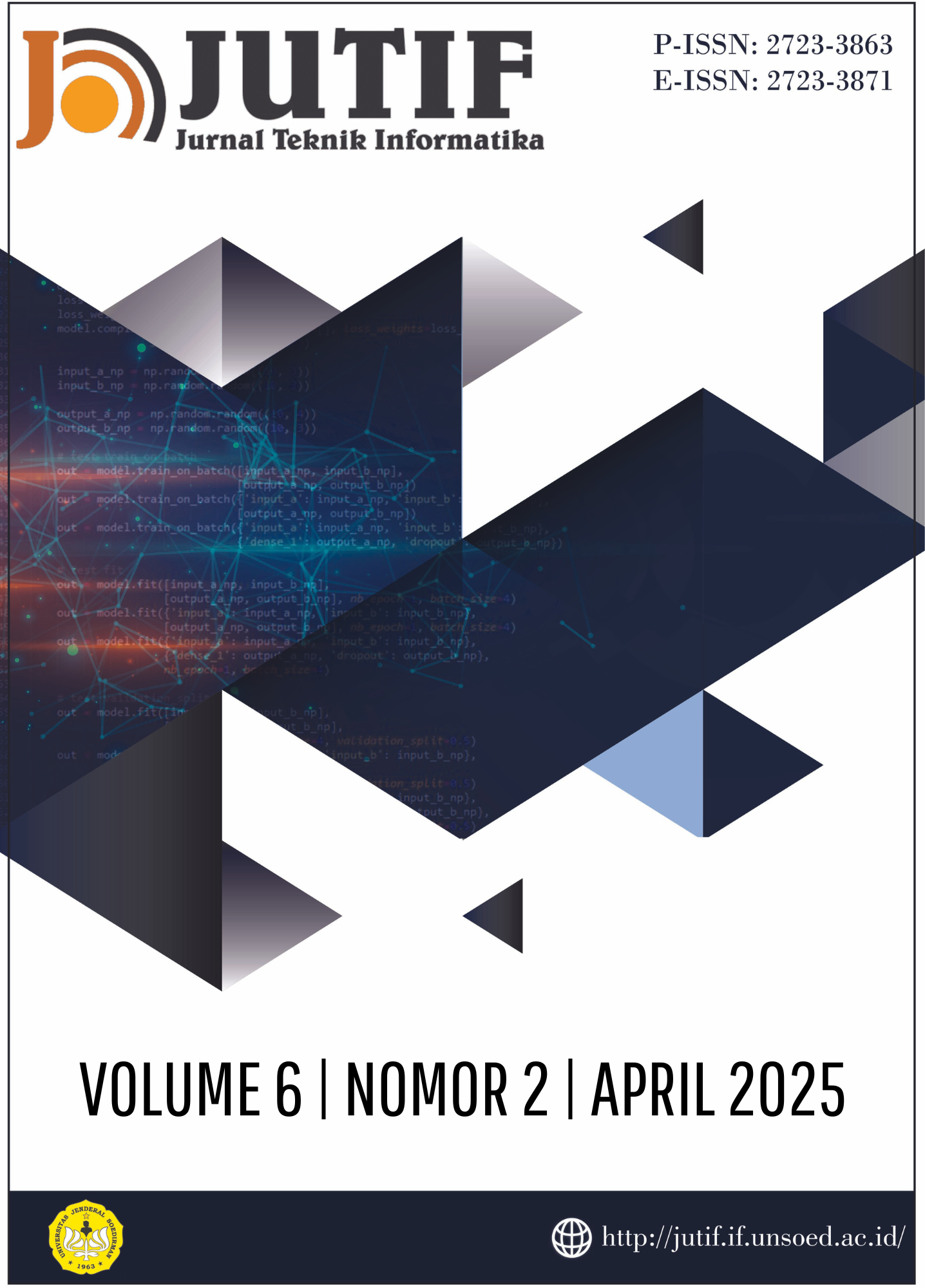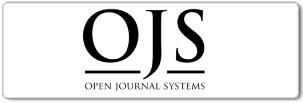Integration of K-Means Clustering and Elbow Method for Mapping Baccaurea spp. Distribution to Support Agroindustrial Development in West Sulawesi
DOI:
https://doi.org/10.52436/1.jutif.2025.6.2.4671Keywords:
Agroindustry, Baccaurea spp., Clustering, Elbow Method, K-Means, MappingAbstract
Baccaurea spp. is a type of wild plant with potential value for sustainable agroindustrial development. This study aims to map and segment regions in West Sulawesi based on the habitat suitability for Baccaurea spp. using K-Means Clustering integrated with the Elbow Method. Field data were collected from 25 villages in Mamasa and Mamuju districts, involving five parameters: land area, production estimate, altitude, humidity, and average temperature. Based on the results of the exploration, 3 species of Baccaurea spp. have been found, namely Baccaurea Lanceolata, Baccaurea Costulata, and Baccaurea Racemosa. The analysis yielded three clusters, with Cluster 1 being identified as the top priority for agroindustrial development due to its high productivity and optimal land conditions. The findings provide a data-driven foundation for policymakers and industries to support the sustainable cultivation of Baccaurea spp. in Indonesia. This research contributes to informatics-based decision-making in agroindustry development and regional planning.
Downloads
References
Á. Vári, I. Arany, Á. Kalóczkai, K. Kelemen, J. Papp, and B. Czúcz, “Berries, greens, and medicinal herbs - Mapping and assessing wild plants as an ecosystem service in Transylvania (Romania),” J. Ethnobiol. Ethnomed., vol. 16, no. 1, pp. 1–14, 2020.
Z. I. Navia, A. B. Suwardi, and T. Harmawan, “The diversity of wild Tampoi (Baccaurea, Phyllantaceae) and their potential to improve the livelihoods of local people in Aceh, Indonesia,” IOP Conf. Ser. Earth Environ. Sci., vol. 1114, no. 1, 2022, doi: 10.1088/1755-1315/1114/1/012088.
H. Mahulae, “Pengelompokan Potensi Produksi Buah-Buahan di Provinsi Sumatera Utara dengan Menerapkan K-Clustering (Studi Kasus : Dinas Tanaman Pangan dan Holtikultura),” JURIKOM (Jurnal Ris. Komputer), vol. 7, no. 2, p. 312, 2020, doi: 10.30865/jurikom.v7i2.2122.
D. F. Pasaribu, I. S. Damanik, E. Irawan, Suhada, and H. S. Tambunan, “Memanfaatkan Algoritma K-Means Dalam Memetakan Potensi Hasil Produksi Kelapa Sawit PTPN IV Marihat,” BIOS J. Teknol. Inf. dan Rekayasa Komput., vol. 2, no. 1, pp. 11–20, 2021, doi: 10.37148/bios.v2i1.17.
I. Sanela, A. Nazir, F. Syafria, E. Haerani, and L. Oktavia, “Penerapan Metode Clustering Dengan K-Means Untuk Memetakan Potensi Tanaman Padi di Sumatera,” J. Comput. Syst. Informatics, vol. 5, no. 1, pp. 82–92, 2023, doi: 10.47065/josyc.v5i1.4523.
E. Muningsih, I. Maryani, and V. R. Handayani, “Penerapan Metode K-Means dan Optimasi Jumlah Cluster dengan Index Davies Bouldin untuk Clustering Propinsi Berdasarkan Potensi Desa,” J. Sains dan Manaj., vol. 9, no. 1, p. 96, 2021, [Online]. Available: www.bps.go.id
B. Wang, G. Wang, Y. Wang, Z. Lou, S. Hu, and Y. Ye, “A K-means clustering method with feature learning for unbalanced vehicle fault diagnosis,” Smart Resilient Transp., vol. 3, no. 2, pp. 162–176, 2021, doi: 10.1108/srt-01-2021-0003.
A. A. Vernanda, A. Faisol, and N. Vendyansyah, “Penerapan Metode K-Means Clustering Untuk Pemetaan Daerah Rawan Kecelakaan Lalu Lintas Di Kota Malang Berbasis Website,” JATI (Jurnal Mhs. Tek. Inform., vol. 5, no. 2, pp. 836–844, 2021, doi: 10.36040/jati.v5i2.3791.
A. Rajsya and A. Rachman, “Rancang Bangun Penerapan Metode Elbow Pada K-Means Untuk Clustering Data Persediaan Barang,” LINIER (Literatur Inform. Komputer), vol. 1, no. 4, pp. 395–403, 2024, doi: 10.33096/linier.vxix.xxxx.
N. A. Maori and E. Evanita, “Metode Elbow dalam Optimasi Jumlah Cluster pada K-Means Clustering,” Simetris J. Tek. Mesin, Elektro dan Ilmu Komput., vol. 14, no. 2, pp. 277–288, 2023, doi: 10.24176/simet.v14i2.9630.
N. T. Hartanti, “Metode Elbow dan K-Means Guna Mengukur Kesiapan Siswa SMK Dalam Ujian Nasional,” J. Nas. Teknol. dan Sist. Inf., vol. 06, no. 02, pp. 82–89, 2020, doi: https://doi.org/10.25077/ TEKNOSI.v6i2.2020.82-89.
A. B. H. Kiat, Y. Azhar, and V. Rahmayanti, “Penerapan Metode K-Means Dengan Metode Elbow Untuk Segmentasi Pelanggan Menggunakan Model RFM (Recency, Frequency & Monetary),” J. Repos., vol. 2, no. 7, pp. 945–952, 2020, doi: 10.22219/repositor.v2i7.973.
M. A. Syakur, B. K. Khotimah, E. M. S. Rochman, and B. D. Satoto, “Integration K-Means Clustering Method and Elbow Method for Identification of the Best Customer Profile Cluster,” IOP Conf. Ser. Mater. Sci. Eng., vol. 336, no. 1, 2018, doi: 10.1088/1757-899X/336/1/012017.
F. Marisa, A. R. Wardhani, W. Purnomowati, A. V. Vitianingsih, A. L. Maukar, and W. Puspitarini, “Potential Customer Analysis Using K-Means With Elbow Method,” vol. 7, no. 2, pp. 307–312, 2023.
P. M. Hasugian, B. Sinaga, J. Manurung, and S. A. Al Hashim, “Best Cluster Optimization with Combination of K-Means Algorithm And Elbow Method Towards Rice Production Status Determination,” Int. J. Artif. Intell. Res., vol. 5, no. 1, pp. 102–110, 2021, doi: 10.29099/ijair.v6i1.232.
S. S. Febrian and A. Mutasowifin, “Selection of agricultural industry stocks by application of K-means algorithm with Elbow method,” BIO Web Conf., vol. 04003, 2025.
T. Santoso, A. Darmawan, N. Sari, M. A. F. Syadza, E. C. B. Himawan, and W. A. Rahman, “Clusterization of Agroforestry Farmers using K-Means Cluster Algorithm and Elbow Method,” J. Sylva Lestari, vol. 11, no. 1, pp. 107–122, 2023, doi: 10.23960/jsl.v11i1.646.
A. M. Ikotun, A. E. Ezugwu, L. Abualigah, B. Abuhaija, and J. Heming, “K-means clustering algorithms: A comprehensive review, variants analysis, and advances in the era of big data,” J. Inf. Sci., vol. 622, pp. 178–210, 2023, doi: 10.1016/j.ins.2022.11.139.
E. Irwansyah and M. Faisal, Advanced Clustering Teori dan Aplikasi. DEEPUBLISH, 2012.
A. A. Abdulnassar and L. R. Nair, “Performance analysis of Kmeans with modified initial centroid selection algorithms and developed Kmeans9+ model,” Meas. Sensors, vol. 25, no. 100666, 2023, doi: 10.1016/j.measen.2023.100666.
J. Pérez-Ortega, N. Nely Almanza-Ortega, A. Vega-Villalobos, R. Pazos-Rangel, C. Zavala-Díaz, and A. Martínez-Rebollar, The K -Means Algorithm Evolution. 2019. doi: 10.5772/intechopen.85447.
N. Solikin, B. Hartono, Sugiono, and Linawati, “Farming in Kediri Indonesia: Analysis of cluster k-means,” IOP Conf. Ser. Earth Environ. Sci., vol. 1041, no. 1, 2022, doi: 10.1088/1755-1315/1041/1/012015.
M. Al Ghifari and W. T. Harsanti Putri, “Clustering Courses Based On Student Grades Using K-Means Algorithm With Elbow Method For Centroid Determination,” Inf. J. Ilm. Bid. Teknol. Inf. dan Komun., vol. 8, no. 1, pp. 42–46, 2023, doi: 10.25139/inform.v8i1.4519.
D. Anggreani and D. Setiawan, “Optimization of K-Means Clustering Method by Using Elbow Method in Predicting Blood Requirement of Pelamonia Hospital Makassar,” Iota, vol. 04, 2024, doi: 10.31763/iota.v4i3.755.
A. Alamsyah et al., “Customer Segmentation Using the Integration of the Recency Frequency Monetary Model and the K-Means Cluster Algorithm,” Sci. J. Informatics, vol. 9, no. 2, pp. 189–196, 2022, doi: 10.15294/sji.v9i2.39437.
D. A. F. Fadhilah, A. Faisol, and N. Vendyansyah, “Penerapan Metode K-Means Clustering Pada Pemetaan Lahan Kopi Di Kabupaten Malang,” JATI (Jurnal Mhs. Tek. Inform., vol. 5, no. 1, pp. 162–170, 2022, doi: 10.36040/jati.v6i1.4617.
D. A. Setiady and H. Leong, “Implementation of K-Means Algorithm Elbow Method and Silhouette Coefficient for Rainfall Classification,” Proxies J. Inform., vol. 4, no. 1, pp. 18–25, 2024, doi: 10.24167/proxies.v4i1.12433.
R. P. Harjono and M. A. I. Pakereng, “Penerapan Metode K-Means Clustering Untuk Analisis Potensi Lahan Pangan Pada Provinsi Kalimantan Selatan,” J-SAKTI (Jurnal Sains Komput. Inform., vol. 7, no. 1, pp. 2549–7200, 2023, [Online]. Available: http://ejurnal.tunasbangsa.ac.id/index.php/jsakti/article/view/596%0Ahttps://ejurnal.tunasbangsa.ac.id/index.php/jsakti/article/viewFile/596/574
S. Noya, N. K. Putrianto, and W. V. Salendu, “Classification of Small and Medium Industry (SMI) in Malang Regency Using K-Means based Clustering Method,” J. Ilm. Tek. Ind., vol. 20, no. 2, pp. 233–238, 2021, doi: 10.23917/jiti.v20i2.15374.
M. Rosyidi and Isnurani, “Analisis Klaster Metode K-Means Dalam Berdasarkan Faktor-Faktor Produksi Bawang Merah,” MATH Vis. J. Mat., vol. 5, no. 1, pp. 16–21, 2023.
D. D. K. Saputra, K. Auliasari, and A. Faisol, “Penerapan Metode K-Means Clustering untuk Pemetaan Pengelompokan Lahan Produksi Jagung di Kabupaten Pasuruan,” JATI (Jurnal Mhs. Tek. Inform., vol. 5, no. 8, pp. 8364–8372, 2024, doi: 10.31294/inf.v10i1.15621.
A. Al Masykur, S. K. Gusti, S. Sanjaya, F. Yanto, and F. Syafria, “Penerapan Metode K-Means Clustering untuk Pemetaan Pengelompokan Lahan Produksi Tandan Buah Segar,” J. Inform., vol. 10, no. 1, 2023, doi: 10.31294/inf.v10i1.15621.
A. M. Khariyani, “Clustering dengan Metode K-Means Berdasarkan Potensi Pertanian di Jawa Tengah,” in Prosiding Seminar Nasional Pendidikan Matematika dan Matematika, 2022. doi: doi.org/10.21831/pspmm.v6i2.246.
Additional Files
Published
How to Cite
Issue
Section
License
Copyright (c) 2025 Heri Irawan, Muhammad Ihsan Fawzi, Syarif Hidayat

This work is licensed under a Creative Commons Attribution 4.0 International License.



























